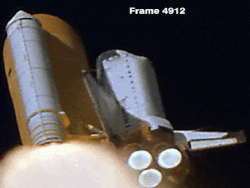Space Shuttle Columbia disaster
The Space Shuttle Columbia disaster occurred when Space Shuttle Columbia broke up when it was reentering the atmosphere on February 1, 2003. The cause of the disaster was that a piece of foam broke from the external fuel tank. This made a hole in the shuttle's wing. During its entry, hot gases entered the wing, causing it to break up. All of the people on board died when it broke up.
 Final launch of Columbia - the part that broke off the fuel tank can be seen as a light triangle by the nose of the Shuttle | |
| Date | February 1, 2003 |
|---|---|
| Time | 08:59 EST (13:59 UTC) |
| Cause | Wing damage from debris |
| Outcome | Shuttles grounded for 29 months |
| Inquiries | Columbia Investigation Board |
Parts of Columbia were found across the state of Texas. The cockpit window is now inside the Space Shuttle Atlantis Pavilion at the Kennedy Space Center in Florida.
Crew
- Commander: Rick D. Husband, a U.S. Air Force colonel and mechanical engineer
- Pilot: William C. McCool, a U.S. Navy commander
- Payload Commander: Michael P. Anderson, a U.S. Air Force lieutenant colonel and physicist
- Payload Specialist: Ilan Ramon, a colonel in the Israeli Air Force
- Mission Specialist: Kalpana Chawla, an Indian-born aerospace engineer
- Mission Specialist: David M. Brown, a U.S. Navy captain and surgeon
- Mission Specialist: Laurel Blair Salton Clark, a U.S. Navy captain and surgeon
Launch & response
Columbia launched on its final mission on January 16, 2003. It was Columbia's 28th flight and the 113th of any Shuttle.
81 seconds into flight, a briefcase-sized part of the external fuel tank's foam insulation, which stops ice from forming while the very cold liquid fuel is in the tank, broke away and hit Columbia. Such debris strikes had happened before - in particular on STS-27 in which a piece of a booster's forward heat shield broke and hit Atlantis' bottom-side heat shield - and were seen as an acceptable risk. However, this debris strike hit Columbia's left wing head on, punching a hole through the panels on the wing's forward edge.
Once high-quality video of the launch was ready, NASA reviewed it and concluded that everything was fine, and stopped engineers from using Department of Defense images from orbit to get a closer look. NASA management thought that even if something were wrong, it would be better for the crew not to know since rescue or repair would be nearly impossible. One flight director contacted Columbia about the concerns, but stressed "we have seen this same phenomenon on other flights and there is absolutely no concern for [re-]entry."
Failed re-entry
On February 1, Columbia prepared to return to Earth on a path that would take it over the USA from west to east. At 8:15 EST, about an hour before Columbia was due to land, it lit its engines and changed its course so that it would re-enter the atmosphere. A 13-minute video recorded in the cabin, ending eleven minutes before the loss of signal from Columbia, shows the astronauts in good spirits and unaware of the danger. As Columbia entered the atmosphere, the air heated up around it due to the Shuttle moving at extreme speeds, over twenty times the speed of sound. This air was able to enter the wing through the hole made during launch, melting through it and causing the Shuttle to lose lift on that side. This loss of lift caused the Shuttle to turn away from its re-entry path, tumble, and break up from the drag of the air.
Columbia passed over California at 8:53. Video shows flashes happening and an unusual trail left behind Columbia, which even hobbyist watchers saw as out of the ordinary. At this point, the temperature of the damaged part of the wing was around 3,000°F (1,650°C). By 8:58 Columbia, still moving at incredible speeds, crossed from New Mexico into Texas, at which point it began shedding debris. By this point several temperature sensors in the damaged left wing had stopped working, and one of the flight controllers reported that the tyre pressure sensors on that side were reporting "off scale low"- meaning that it is a reading that falls below the minimum capability of the sensor, and it usually indicates that the sensor has stopped functioning, due to internal or external factors, not that the quantity it measures is actually below the sensor's minimum response value.
The last communication with commander Rick Husband was "Roger, uh bu-" at 8:59. 45 seconds later, video from the ground shows Columbia breaking apart. Mission Control began its disaster procedures at 9:12.
Space Shuttle Columbia Disaster Media
Columbia prior to launch. The circled area on the external tank (ET) is the left bipod foam ramp, and the circled area on the orbiter is the location that was damaged.
Video taken by the crew ends four minutes before the disaster.
Columbia at about 08:57. Debris is visible coming from the left wing (bottom). The image was taken at Starfire Optical Range at Kirtland Air Force Base.
The breakup of Columbia was captured by a forward-looking infrared (FLIR) camera mounted on an Apache helicopter conducting training in Fort Hood, Texas.
President George W. Bush's address on the Columbia disaster, February 1, 2003








